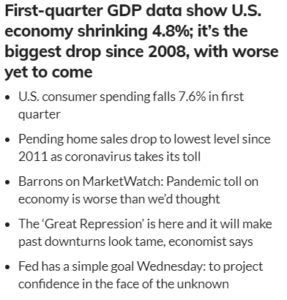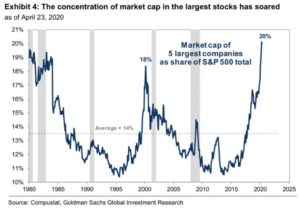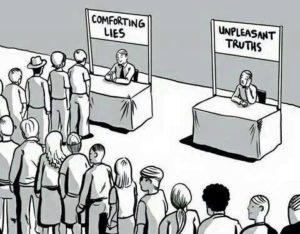May 1, 2020
Thankfully, we have seen a nice relief rally in the stock market since the lows were reached on March 23rd. April posted the largest monthly gain since 1987, up 12.7% for the month, clawing back a good portion of the losses incurred in February and March.
It appears that the government’s “double-bazooka” of loose monetary policy and fiscal stimulus has saved the markets from the worst-case scenario situation.
However, this does not mean that we are out of the woods yet. Now comes the slow grind of daily bad news, which is starting to trickle in this week. The news has been even worse than expected. 1st quarter GDP came in at -4.8% compared to an expected GDP number of -4%. Consumer spending was expected to be down -3.6%, but it was down -7.6%. Here are some of the headlines from today.
You would assume that the stock market would react negatively to these numbers. Well, not exactly. The same day these results were released, the Dow Jones was up over 500 points.
THE BROADER MARKET
The stock market seems steadily focused on a handful of companies that are still doing well and not the hundreds of companies that are struggling. We are now entering corporate earnings season where companies will report their results and give guidance for the future. So far, only 50% of companies that have reported earnings have provided any guidance for the future. This is because they honestly do not know what the future will bring.
The darlings of the S&P 500 (Google, Microsoft, Facebooks, Apple, and Amazon) are reporting this week. These tech giants will likely report solid earnings, but we must keep in mind that they are only a sliver of the market.
A little-known fact is that the same 5 companies listed above, make up 20% of the S&P 500 total market value (see chart below). To say that another way, this means that 1% of the companies in the S&P 500 make up 20% of the total value of the entire index. We have not seen this concentration of stocks since the dot.com era, where a small number of companies made up 18% of the market. For the historians out there, the top companies in 1999 were Microsoft, General Electric, Cisco, Exxon Mobil, and Walmart, in that order.
Five years later (in 2004), Microsoft had lost over 50% of its market value, General Electric over 36%, and Cisco over 60%. Exxon Mobil and Walmart were unchanged. We are not predicting a similar fate for our S&P 500 darlings, but it is something to be mindful of. Even the best run companies in the world can get overvalued.
IS THE NEXT LEG UP OR DOWN?
As companies start reporting their blemishes and adjusting their outlook for the future, stock investors will be deciding whether the new information is better or worse than expected. If it is worse, markets will adjust down, and if better they will adjust up.
It appears that the stock market has priced in a “V” shaped, quick recovery from the COVID-19 shutdowns, but the recovery may take longer than we expect. There could be some unpleasant truths that present themselves that make this a “U” shaped longer recovery, lasting well into next year.
Employers may not hire back many of their employees. We may start to see rising loan defaults that could continue into next year. We may see consumers, still afraid, delay returning to restaurants, movie theaters, and other places that people congregate. We just do not know how this is going to play out, and neither do stock investors.
We do not want our words of caution to overshadow the incredible stories that have emerged from the pandemic. It is impossible not to be inspired by our front-line healthcare workers and first responders, they are true heroes. American ingenuity is on display as drug companies work around the clock to develop treatments and a vaccine for the virus. The ingenuity and mobilization of the private sector is the true success story of this pandemic. However, we must be pragmatists. The reality remains that jump-starting the largest economy in the world is no small feat. Not to mention that the COVID-19 virus is a worldwide phenomenon.
THE MONTHS TO COME
In the months to come, we will see if the government’s double-bazooka stimulus plan was enough. We sure hope so. However, some economists believe that an additional $2-3 trillion dollars of government stimulus could be required later this year to keep the economy afloat–as each state, county, and city looks to get their hands on some of the stimulus money. Federal Reserve Chair Powell suggested this week that more stimulus may be needed to prop up businesses and consumers.
This market is no longer about how strong company fundamentals are, but rather, how much stimulus the government puts into the system.
Our advice is to stay invested in this market, but tread carefully. “Drive with one foot on the brake” as we like to say. Stock investors are forward-looking and are expecting the economy to be back to normal in 2021, while the bond market, widely known as the “smart money”, is signaling an entirely different picture; a negative one. The 10-year treasury is currently yielding 0.60%, which means investors are willing to take a pittance of a return in exchange for safety. One of these markets will be more right than the other. Let us hope the stock market is the winner, and that our recovery is strong and quick.
We will know soon enough.
As always, we appreciate your trust and are here to support you in every way we can.
-RS Crum




